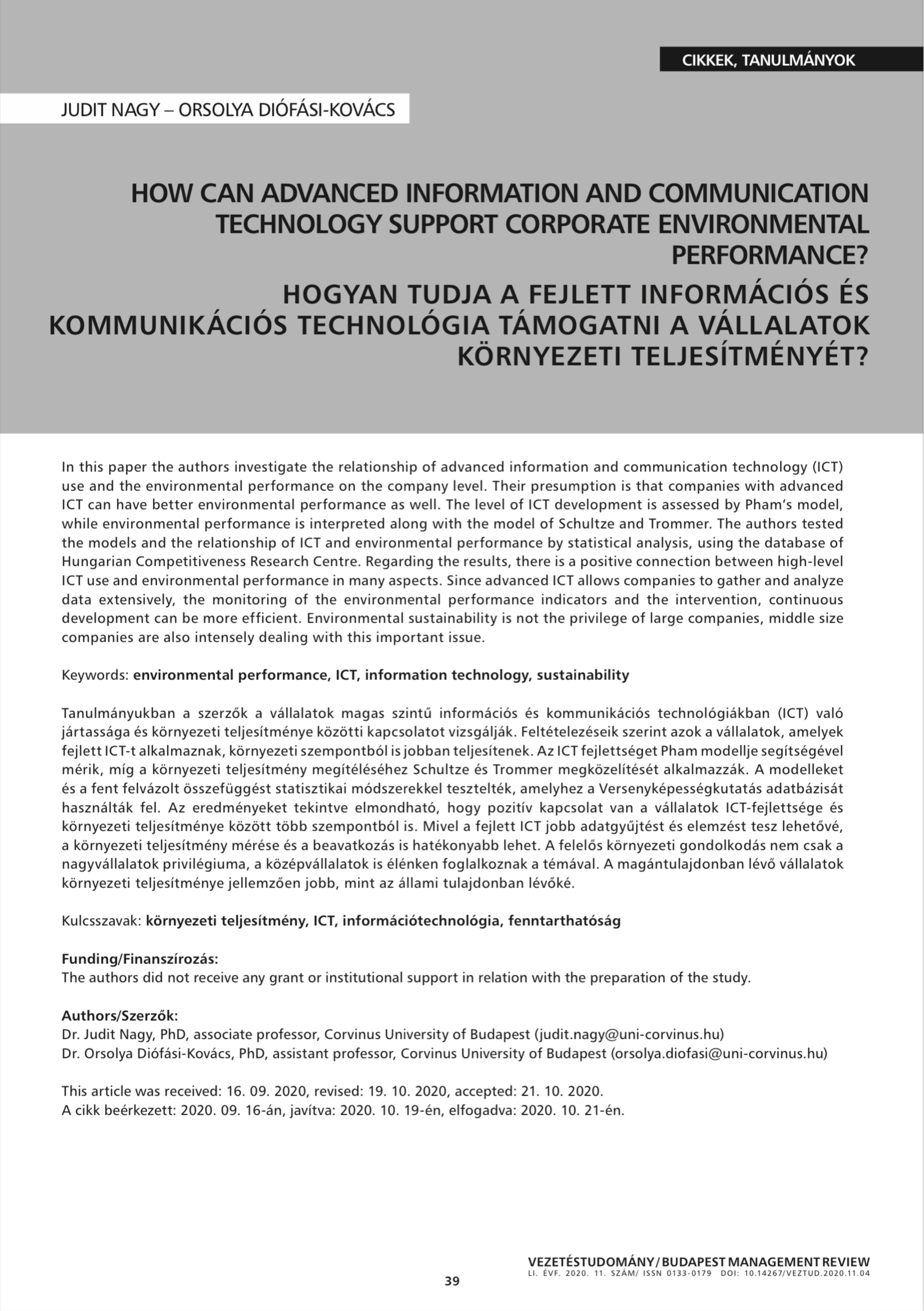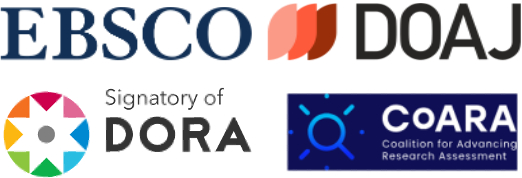How can advanced information and communication technology support corporate environmental performance?
DOI:
https://doi.org/10.14267/VEZTUD.2020.11.04Kulcsszavak:
környezeti teljesítmény, ICT, információtechnológia, fenntarthatóságAbsztrakt
Tanulmányukban a szerzők a vállalatok magas szintű információs és kommunikációs technológiákban (ICT) való jártassága és környezeti teljesítménye közötti kapcsolatot vizsgálják. Feltételezéseik szerint azok a vállalatok, amelyek fejlett ICT-t alkalmaznak, környezeti szempontból is jobban teljesítenek. Az ICT fejlettséget Pham modellje segítségével mérik, míg a környezeti teljesítmény megítéléséhez Schultze és Trommer megközelítését alkalmazzák. A modelleket és a fent felvázolt összefüggést statisztikai módszerekkel tesztelték, amelyhez a Versenyképességkutatás adatbázisát használták fel. Az eredményeket tekintve elmondható, hogy pozitív kapcsolat van a vállalatok ICT-fejlettsége és környezeti teljesítménye között több szempontból is. Mivel a fejlett ICT jobb adatgyűjtést és elemzést tesz lehetővé, a környezeti teljesítmény mérése és a beavatkozás is hatékonyabb lehet. A felelős környezeti gondolkodás nem csak a nagyvállalatok privilégiuma, a középvállalatok is élénken foglalkoznak a témával. A magántulajdonban lévő vállalatok környezeti teljesítménye jellemzően jobb, mint az állami tulajdonban lévőké.
Letöltések
Hivatkozások
Antoni, D., & Jie, F. (2012). The relationship between IT capability and organizational environment performance: A conceptual framework. In 3rd Annual international Conference on Infocomm Technologies in Competitives Strategies (ICT 2012) (pp. 47 – 53). Bali.
Bansal, P., & Roth, K. (2000). Why companies go green: A model of ecological responsiveness. Academy of Management Journal, 43(4), 717-736. https://doi.org/10.5465/1556363
Becker, J., Knackstedt, R., & Pöppelbuß, J. (2009) Developing maturity models for IT management. Business and Information Systems Engineering, 1(3), 213-222. https://doi.org/10.1007/s12599-009-0044-5
Benitez-Amado, J., Llorens-Montes, F. J., & Fernandez-Perez, V. (2015) IT impact on talent management and operational environmental sustainability. Information Technology and Management, 16(3), 207-220. https://doi.org/10.1007/s10799-015-0226-4
Butti Al Shamsi, K., Guarnaccia, P., Cosentino, S. L., Leonardi, C., Caruso, P., Stella, G., & Timpanaro, G. (2019). Analysis of Relationships and Sustainability Performance in Organic Agriculture in the United Arab Emirates and Sicily (Italy). Resources, 8(1), 39. https://doi.org/10.3390/resources8010039
Cai, S., Chen, X., & Bose, I. (2013). Exploring the role of IT for environmental sustainability in China: An empirical analysis. International Journal of Production Economics, 146(2), 491-500. https://doi.org/10.1016/j.ijpe.2013.01.030
Cecere, G., Corrocher, N., Gossart, C., & Ozman, M. (2014). Technological pervasiveness and variety of innovators in Green ICT: A patent-based analysis. Research Policy, 43(10), 1827-1839. https://doi.org/10.1016/j.respol.2014.06.004
Chesher, M., & Skok, W. (2000). Roadmap for successful information technology transfer for small businesses. In Proceedings of the 2000 ACM SIGCPR conference on Computer personnel research, (pp. 16-22). New York: Association for Computing Machinery.
Demeter, K., Losonci, D., & Nagy, J. (2020). Road to digital manufacturing–a longitudinal case-based analysis. Journal of Manufacturing Technology Management, In press https://doi.org/10.1108/JMTM-06-2019-0226
Eisenhardt, K. M., & Martin, J. A. (2000). Dynamic capabilities: what are they? Strategic Management Journal, 21(10), 1105-1121. Retrieved from https://www.jstor.org/stable/3094429
Evangelista, P., Santoro, L., & Thomas, A. (2018). Environmental sustainability in third-party logistics service providers: A systematic literature review from 2000–2016. Sustainability, 10(5), 1627. https://doi.org/10.3390/su10051627
Gaviglio, A., Bertocchi, M., & Demartini, E. (2017). A tool for the sustainability assessment of farms: selection, adaptation and use of indicators for an Italian case study. Resources, 6(4), 60. https://doi.org/10.3390/resources6040060
Gimenez, C., Sierra, V., Rodon, J., & Rodriguez, J. A. (2015). The role of information technology in the environmental performance of the firm: The interaction effect between information technology and environmental practices on environmental performance. Academia Revista Latinoamericana de Administración, 28(2), 273-291. https://doi.org/10.1108/ARLA-08-2014-0113
Higón, D. A., Gholami, R., & Shirazi, F. (2017). ICT and environmental sustainability: A global perspective. Telematics and Informatics, 34(4), 85-95. https://doi.org/10.1016/j.tele.2017.01.001
Hilty, L.M., Lohmann, W., & Huang, E. M. (2011). Sustainability and ICT – An overview of the field. Politeia, 27(104), 13-28. https://doi.org/10.5167/uzh-55640
Howard, S. (2013). Let’s go all in on selling sustainability. Ted Talk. Retrieved from https://www.youtube.com/watch?v=buH_vs7LFzw
Hungarian Competitiveness Research Centre (2013). Retrieved from https://www.uni-corvinus.hu/mainpage/research/research-centres/competitivenessresearch-centre/about/?lang=en
Ishida, H. (2015). The effect of ICT development on economic growth and energy consumption in Japan. Telematics and Informatics, 32(1), 79-88. https://doi.org/10.1016/j.tele.2014.04.003
ISO (2015). ISO 14001:2015. Terms and definitions –Environmental performance. Retrieved from https://committee.iso.org/files/live/sites/tc207sc1/files/Terms%20and%20definitions%20in%20ISO%2014001_2015%20-%20where%20did%20they%20originate%20from.pdf
Kayikci, Y. (2018). Sustainability impact of digitization in logistics. Procedia Manufacturing, 21, 782-789. https://doi.org/10.1016/j.promfg.2018.02.184
Konar, S., & Cohen, M. A. (2001). Does the market value environmental performance? Review of Economics and Statistics, 83(2), 281-289. https://doi.org/10.1162/00346530151143815
Kraus S., Rehman S., & García F.J.S. (2020). Corporate social responsibility and environmental performance: The mediating role of environmental strategy and green innovation, Technological Forecasting and Social Change, 160,120262. https://doi.org/10.1016/j.techfore.2020.120262
Lee, J. W., & Brahmasrene, T. (2014). ICT, CO2 emissions and economic growth: Evidence from a panel of ASEAN. Global Economic Review, 43(2), 93-109. https://doi.org/10.1080/1226508X.2014.917803
Lenka, S., Parida, V., & Wincent, J. (2017). Digitalization capabilities as enablers of value co‐creation in servitizing firms. Psychology and Marketing, 34(1), 92-100. https://doi.org/10.1002/mar.20975
Matthews, H. S., Williams, E., Tagami, T., & Hendrickson, C. T. (2002). Energy implications of online book retailing in the United States and Japan. Environmental Impact Assessment Review, 22(5), 493-507. https://doi.org/10.1016/S0195-9255(02)00024-0
Melville, N.P. (2010). Information systems innovation for environmental sustainability. MIS Quarterly, 34(1), 1-21. Retrieved from https://www.misq.org/downloadable/download/linkSample/link_id/838/
Mihalic, T., & Buhalis, D. (2013). ICT as a new competitive advantage factor – Case of small transitional hotel sector. Economic and Business Review for Central and South-Eastern Europe, 15(1), 33-56. Retrieved from https://www.researchgate.net/publication/269113660_ICT_as_a_competitive_advantage_factor_-_case_of_small_transitional_hotel_sector
Ollo-López, A., & Aramendía-Muneta, M.E. (2011). ICT impact on competitiveness, innovation and environment, Telematics and Informatics, 29(2), 204-210. https://doi.org/10.1016/j.tele.2011.08.002
Pekovic, S., Grolleau, G., & Mzoughi, N. (2018). Environmental investments: too much of a good thing? International Journal of Production Economics, 197, 297-302. https://doi.org/10.1016/j.ijpe.2018.01.012
Pham, Q. T. (2010). Measuring the ICT maturity of SMEs. Journal of Knowledge Management Practice, 11(1), 1-14. Retrieved from http://www.tlainc.com/articl223.htm?WPxsVfOoGuGtmAXI-oCgBQ&ved=0CC4QFjAF&usg=AFQjCNEnrDICES-9k9ayazP24GqdeTimwQ
Powell, T. C., & Dent‐Micallef, A. (1997). Information technology as competitive advantage: The role of human, business, and technology resources. Strategic Management Journal, 18(5), 375-405. https://doi.org/10.1002/(SICI)1097-0266(199705)18:5<375::AID-SMJ876>3.0.CO;2-7
Radu, L. D. (2016). Determinants of green ICT adoption in organizations: a theoretical perspective. Sustainability, 8(8), 731. https://doi.org/10.3390/su8080731
Sajtos, L. & Mitev, A. (2007). SPSS kutatási és adatelemzési kézikönvy. (SPSS research and analytics handbook). Budapest, Hungary: Alinea.
Schultze, W., & Trommer, R. (2012). The concept of environmental performance and its measurement in empirical studies. Journal of Management Control, 22(4), 375-412. https://doi.org/10.1007/s00187-011-0146-3
Seuring, S., & Müller, M. (2008). From a literature review to a conceptual framework for sustainable supply chain management. Journal of Cleaner Production, 16(15), 1699-1710. https://doi.org/10.1016/j.jclepro.2008.04.020
Sheth, J. N., Sethia, N. K., & Srinivas, S. (2011). Mindful consumption: a customer-centric approach to sustainability. Journal of the Academy of Marketing Science, 39(1), 21-39. https://doi.org/10.1007/s11747-010-0216-3
Song, M., Fisher, R., Wang, J., & Cui, L.B. (2018). Environmental performance evaluation with big data: theories and methods. Annual Operations Research, 270(1-2), 459–472. https://doi.org/10.1007/s10479-016-2158-8
Subburaj, S., & Kulkarni, S. (2014). Analysis of Green IT Features for Improving Business Performance. International Journal for Infonomics (IJI), 7(1/2), 867-873. https://doi.org/10.20533/iji.1742.4712.2014.0103
Tuni A., Rentizelas A., & Duffy, A. (2018). Environmental performance measurement for green supply chains: A systematic analysis and review of quantitative methods. International Journal of Physical Distribution & Logistics Management, 48(8), 765-793. https://www.doi.org/10.1108/IJPDLM-02-2017-0062
Wang, Y., Sanchez Rodrigues, V., & Evans, L. (2015). The use of ICT in road freight transport for CO2 reduction – An exploratory study of UK’s grocery retail industry. International Journal of Logistics Management, 26(1), 2–29. https://doi.org/10.1108/IJLM-02-2013-0021
Watts, S. (2015). Corporate social responsibility reporting platforms: enabling transparency for accountability. Information Technology and Management, 16(1), 19-35. https://doi.org/10.1007/s10799-014-0192-2
Weber, D. M., & Kauffman, R. J. (2011). What drives global ICT adoption? Analysis and research directions. Electronic Commerce Research and Applications, 10(6), 683-701. https://doi.org/10.1016/j.elerap.2011.01.001
Yi, L., & Thomas, H. R. (2007). A review of research on the environmental impact of e-business and ICT. Environment International, 33(6), 841-849. https://doi.org/10.1016/j.envint.2007.03.015
Zahra, S.A., & George, G. (2002). Absorptive capacity: a review, reconceptualization, and extension. Academy of Management Review, 27(2), 185-203. https://doi.org/10.5465/amr.2002.6587995

Downloads
Megjelent
Hogyan kell idézni
Folyóirat szám
Rovat
License
Copyright (c) 2020 Vezetéstudomány / Budapest Management Review

This work is licensed under a Creative Commons Attribution 4.0 International License.
Authors assign copyright to Vezetéstudomány / Budapest Management Review. Authors are responsible for permission to reproduce copyright material from other sources.

